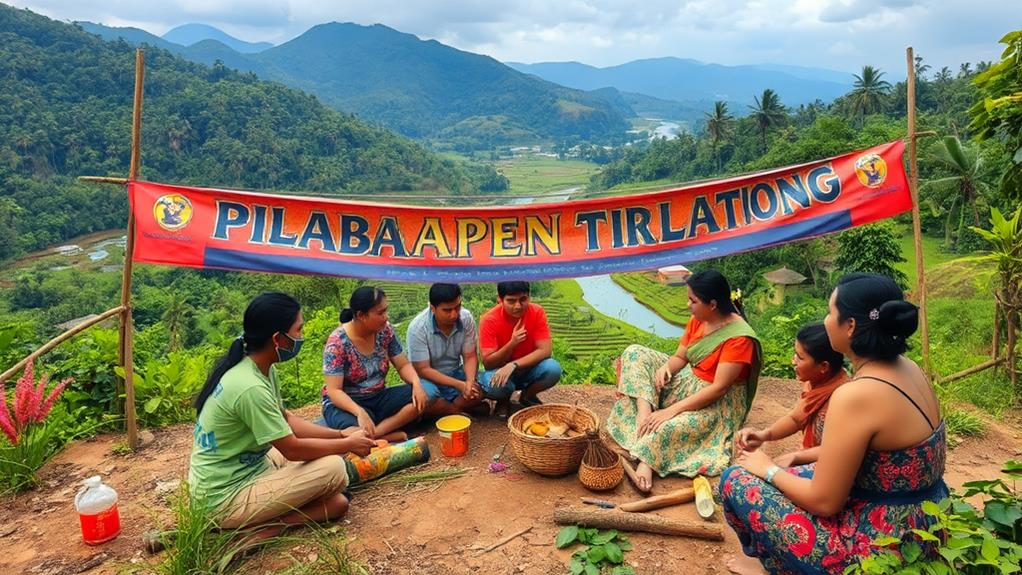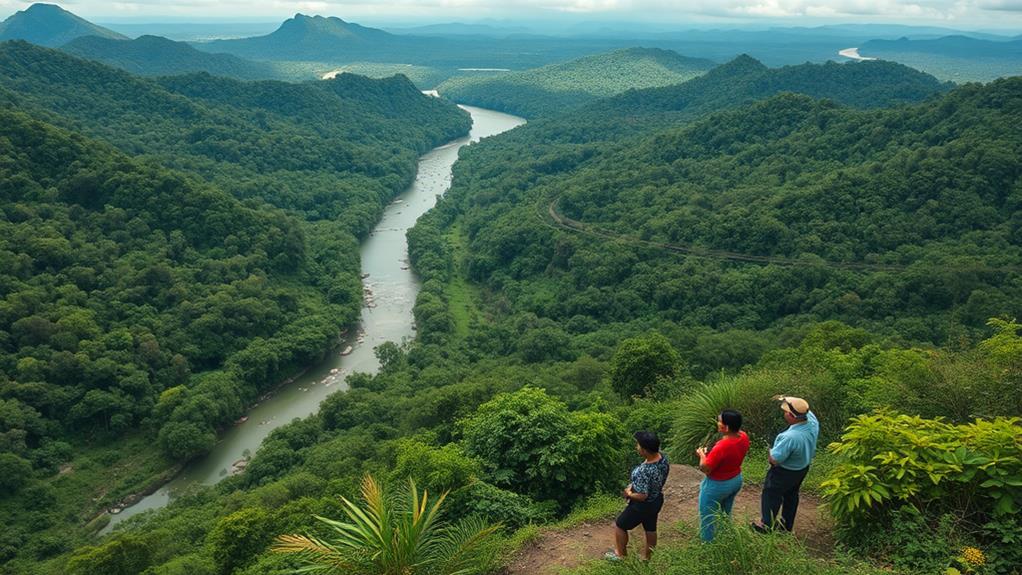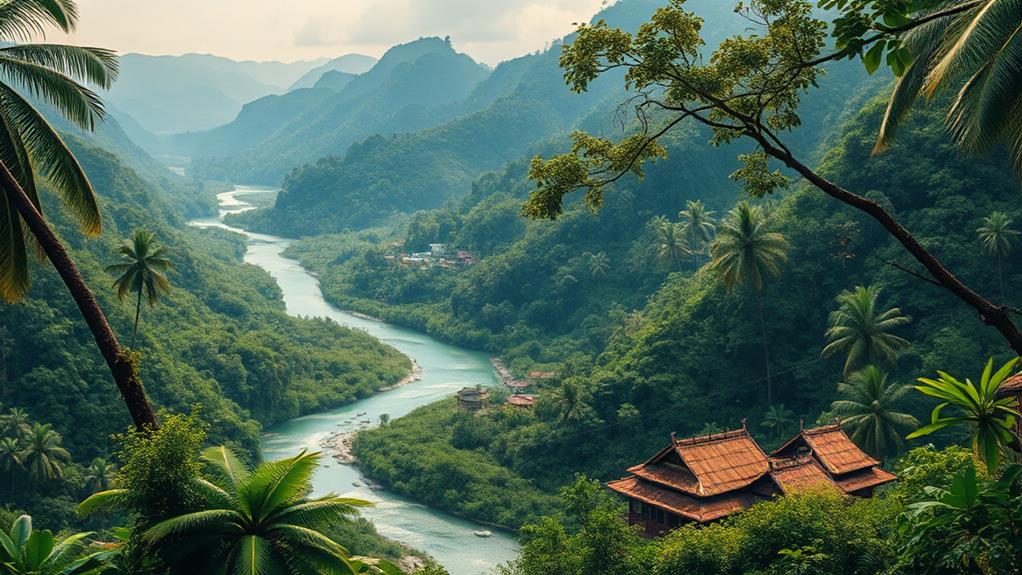The future of natural resource management in the Philippines depends on good governance and community involvement. Programs like Payment for Ecosystem Services (PES) help local economies while encouraging environmental conservation. For example, farmers can receive money for protecting forests that provide clean water. This not only benefits the farmers financially, but also helps maintain the health of the ecosystem. Additionally, with the growing impact of climate change, it is crucial for the government and local communities to work together to implement sustainable practices that will help mitigate the effects of environmental degradation. Through collaborative efforts and effective management, the Philippines can ensure the longevity of its natural resources for future generations.
Training programs are designed to empower communities. These programs teach people how to protect biodiversity and manage their resources responsibly. For instance, workshops can show local fishermen how to catch fish sustainably, which helps keep fish populations healthy.
To combat illegal exploitation, communities receive support through capacity building. This means giving them tools and knowledge to follow environmental laws. For example, training local patrols can reduce illegal logging in protected areas.
Innovative practices like natural capital accounting are essential. This method tracks the value of natural resources, helping leaders make better economic decisions. For instance, knowing the economic value of forests can influence policies to protect them.
Addressing issues like overfishing and pollution is crucial for ensuring a sustainable future. For example, stricter fishing limits can help fish populations recover.
In summary, these strategies are reshaping resource management for a more resilient Philippines.
Governance and Community Engagement

Governance and community engagement are essential for managing natural resources in the Philippines. Effective governance structures and community involvement work together to protect biodiversity.
For example, training programs for community volunteers and local government staff help local people gain skills for conducting ecological assessments. This leads to better decision-making about natural resources.
When communities participate in biodiversity assessments, they develop a sense of stewardship and accountability. This is important for sustainable development.
A good example is community-led projects like sustainable tree nurseries and eco-tourism. These projects not only help protect the environment but also improve local livelihoods.
Moreover, initiatives like WAVES show that it's important to include natural resource accounting in national economic plans. This highlights the need for multi-stakeholder engagement in governance.
Economic Incentives for Conservation
Economic incentives for conservation are essential in the Philippines for managing natural resources. These incentives help improve local economies while protecting marine life and supporting communities, including indigenous groups.
Community savings groups provide small loans to help families start new businesses and support conservation. This allows families to earn more money while taking care of the environment.
The Meloy Fund invests $17.5 million over 12 years to encourage sustainable fishing. This funding helps improve the health of marine ecosystems, ensuring fish populations can thrive.
Payment for Ecosystem Services (PES) programs allow communities to earn money by protecting natural resources. These programs create a steady income for locals while promoting conservation efforts.
Community eco-tourism initiatives focus on protecting mangrove forests. These projects not only conserve important ecosystems but also provide extra income for local residents, making communities more resilient.
Overall, integrating these economic strategies with conservation goals helps protect biodiversity and meet the economic needs of communities.
Addressing Illegal Resource Exploitation

Illegal resource exploitation is a major problem in the Philippines. It harms the livelihoods and food security of millions and disrupts sustainable marine resource management. Illegal fishing and poaching affect the marine resources that coastal communities rely on, increasing their challenges.
To fight this issue, capacity building initiatives are important. These programs help local governments enforce environmental laws. This improves their ability to protect marine ecosystems.
Community-led Bantay Dagat sea patrollers play a key role in monitoring protected areas. They help stop illegal activities by encouraging community accountability.
Training for local government workers and volunteers teaches them about ecological assessments. This training enables them to identify species, habitats, and threats to marine biodiversity.
Additionally, specific protection measures for endangered species, such as giant clams and sea turtles, help reduce the effects of illegal exploitation.
This approach not only improves natural resource management but also boosts the resilience of coastal communities against illegal activities. Continuing these initiatives is crucial for maintaining a balanced ecosystem where both people and nature can thrive.
Importance of Biodiversity Protection
Protecting biodiversity is crucial for the Philippines' environment and its people's livelihoods. About 70% of the world's plant and animal species live in the Philippines, making biodiversity protection important for food security and economic stability.
Prioritizing biodiversity protection offers several benefits:
- Ecosystem resilience: Healthy ecosystems can better withstand climate change.
- Sustainable resources: Local communities rely on these resources for their livelihoods.
- Food security: Healthy ecosystems support fisheries and agriculture.
- Economic growth: Protecting biodiversity helps preserve resources for future generations.
Ecosystem degradation from activities like farming, hunting, and logging threatens biodiversity. By protecting these ecosystems, we support both ecological health and community well-being.
Sustainable resource management can empower local communities with the skills they need to succeed.
Investing in biodiversity creates a sustainable future where the environment and people thrive together.
Immediate action is essential; your role in protecting biodiversity can have a lasting impact and help ensure that the Philippines remains a vibrant hub of life for future generations.
Role of International Aid

International aid is crucial for improving the management of natural resources in the Philippines. It provides support for sustainable practices and helps local governments.
For example, the USAID SIBOL Activity focuses on protecting biodiversity and natural resources by tackling illegal fishing and wildlife crimes. This partnership helps local authorities build their skills to enforce environmental laws more effectively.
Another example is the Meloy Fund, which has invested $17.5 million over the last 12 years to promote sustainable practices among local fishing businesses. This funding encourages the use of environmentally friendly technologies, which are important for long-term sustainability.
Additionally, collaboration with the U.S. Department of Interior offers technical help to fight wildlife crimes and illegal fishing. The Global Program on Sustainability (GPS) from the World Bank also supports the integration of sustainability into decision-making in the Philippines.
Challenges in Natural Resource Management
Natural resource management in the Philippines faces serious challenges. These issues threaten the environment and the livelihoods of many people. For example, overfishing and illegal fishing practices are harming the country's rich coastal and marine resources. This not only affects food security but also the jobs of 1.4 million people working in the fisheries sector.
Key challenges include:
- Rising greenhouse gas emissions caused by urbanization and plastic waste.
- Water and air pollution that exceed health standards, putting public health at risk.
- Climate change impacts that increase natural disasters, which hurt agriculture and forestry.
- Displacement of indigenous communities due to extractive industries, even though they contribute little to the economy.
These factors make it hard to manage natural resources sustainably. Many Filipinos are against mining practices, highlighting the need for sustainable methods that protect both the environment and the rights of indigenous people.
Addressing these challenges is essential to ensure a resilient future and safeguard the livelihoods of those relying on these resources. Without a clear strategy, the situation will get worse, harming ecosystems and public health.
Innovative Practices and Technologies

Innovative practices and technologies are changing how natural resources are managed in the Philippines. Natural capital accounting (NCA) helps include natural resources in the country's economic plans. This ensures that development is carefully planned.
Sustainable tree nurseries are becoming popular. These nurseries help communities earn extra income while also protecting local biodiversity. They increase forest cover and improve the livelihoods of local people.
Additionally, community eco-tourism initiatives focused on mangrove forests are developing. These projects protect important ecosystems and create jobs for residents.
Payment for Ecosystem Services (PES) is another key practice. It offers a way to fund conservation efforts. By putting a value on the benefits that nature provides, communities can be involved in protecting biodiversity for the future.
Combining scientific research with economic incentives improves resource management. This approach not only helps preserve biodiversity but also supports green growth. It ensures that everyone involved benefits from using natural resources wisely.
Adopting these innovative practices is vital for the Philippines as it faces challenges in managing its natural resources and aims for a sustainable future.
Future Strategies for Sustainability
Sustainable development strategies in the Philippines focus on natural capital accounting within the nation's economy. This approach aims to manage natural resources responsibly while achieving sustainable development goals.
Here are some important strategies:
- Engage multiple stakeholders through the Philippine Extractive Industries Transparency Initiative (PH-EITI). This initiative improves governance and makes sure that resource management is clear and accountable.
- Create Payment for Ecosystem Services (PES) programs. These programs will help finance conservation efforts and give power to local communities to protect biodiversity over time.
- Launch sustainable fisheries programs to increase fish stocks by 10% by 2025. This effort addresses overfishing and is critical for food security.
- Fight plastic pollution with the Clean Cities program. This program promotes the 3Rs—reduce, reuse, recycle—and enhances waste management systems.
These strategies aim to protect biodiversity and strengthen ecosystems. By involving different groups, the Philippines can collaborate effectively on managing natural resources.
Addressing issues like plastic pollution is essential for the health of ecosystems. Following these strategies is important for the long-term sustainability of the Philippines' natural resources.
Questions and Answers
What Are the Problems With Natural Resource Management in the Philippines?
Illegal logging and overfishing are serious problems in the Philippines. Illegal logging occurs when trees are cut down without permission, leading to the loss of forests and wildlife habitats. For example, in some areas, illegal logging has caused landslides and floods. Overfishing happens when too many fish are caught, which can lead to the depletion of fish populations. This affects not only fishermen but also the entire ecosystem.
Weak mining regulations make these problems worse. Weak mining regulations mean that companies can extract minerals without following strict rules, which can lead to environmental damage. For instance, mining can pollute rivers and harm local communities who rely on clean water.
Inadequate policy enforcement further complicates resource management. Inadequate policy enforcement means that even when laws exist, they are not always followed or enforced. This allows illegal activities to continue without punishment.
Climate change adds another layer of difficulty. Climate change can cause extreme weather events like typhoons and droughts, which hurt both natural resources and local communities.
What Are the Top 5 Natural Resources in the Philippines?
The top natural resources in the Philippines are nickel, gold, copper, freshwater, and marine biodiversity.
Nickel is important for making stainless steel and batteries. The Philippines is one of the largest producers of nickel in the world.
Gold is highly valued for jewelry and electronics. The country has several gold mines that contribute significantly to its economy.
Copper is used in electrical wiring and plumbing. The Philippines has rich copper deposits, making it a major exporter of this metal.
Freshwater resources are crucial for drinking, agriculture, and industry. Rivers and lakes in the Philippines support both people and wildlife.
Marine biodiversity includes a wide variety of fish and coral species. The country's waters are among the richest in the world, providing food and income for many communities.
What Factors Contribute to the Philippines Being Rich in Natural Resources?
The Philippines has many natural resources because of its rich biodiversity and sustainable practices. Biodiversity refers to the variety of life in the country, including plants, animals, and ecosystems. For example, the Philippines is home to unique species like the Philippine Eagle and various endemic plants.
Sustainable practices help protect these resources. This means using resources in a way that does not harm the environment. For instance, some communities use traditional farming methods that maintain soil health and protect water sources.
Indigenous knowledge plays a key role in managing these resources. Indigenous people have lived in harmony with their environment for generations. Their practices, such as crop rotation and natural pest control, contribute to the health of the ecosystem.
Government policies also promote economic benefits. These policies encourage responsible use of resources, leading to job creation and community development. Moreover, when communities are involved in resource management, they can better address environmental challenges.
In summary, the Philippines is rich in natural resources due to its biodiversity, sustainable practices, and the wisdom of indigenous peoples. These factors work together to enhance the country's natural wealth while protecting the environment.
What Will Happen to Our Natural Resources in the Future?
Natural resources will face serious problems in the future due to climate change and resource depletion. For example, rising temperatures can lead to droughts that reduce water supplies, while overfishing can harm fish populations. To address these issues, we need to focus on sustainable practices. This means using resources in a way that does not damage the environment.
Community involvement is also important. When local people work together to protect their environment, they can create stronger conservation efforts. For instance, community-led clean-up events can help restore local parks and waterways.
Lastly, policy reforms are essential. Laws that encourage renewable energy use, such as solar or wind power, can help reduce our reliance on fossil fuels. These changes not only help the environment but also support the economy by creating new jobs.